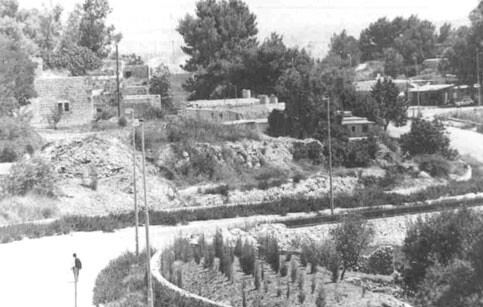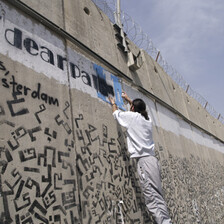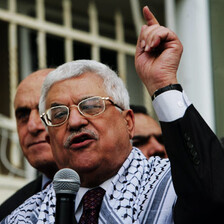Utrecht, the Netherlands 9 April 2004

Deir Yassin: New road around the southern border of the village, looking north. The ruins in the foreground are those of the dayr (“monastry”) after which the village was named (Photo: All that remains, Walid Khalidi, 1986)
Fifty-six years ago, 11-year old Fahimi Zeidan lived with her family in the Palestinian village Deir Yasin. The livelihood of the village largely dependend on agriculture and by residents keeping livestock. Many others worked in Jerusalem. The area around the village was rich of limestone. The villagers excavated quarries and developed a thriving industry in stone cutting. As the village prospered its homes radiated from the Hara uphill and eastward, towards Jerusalem. The village, which was home to some 700 residents, was a prosperous, expanding village at relative peace with its Jewish neighbours with whom much business was done.
On the eve of the war, Deir Yassin and the adjacent Jewish colony of Giv’at Sha’ul signed an agreement promising to be good neighbors. This agreement was approved by Haganah headquarters in Jerusalem.
However, on the 9th of April 1948, Zionist forces entered the home of Fahimi Zeidan, ordered her family to line up against the wall and started shooting. Fahimi, two sisters and brother were saved because they could hide behind their parents. But all the others against the wall were killed: her father, mother, grandfather and grandmother, uncles and aunts and some of their children.
“As soon as the sun rose, there was knocking at the door, but we did not answer. They blew the door down, entered and started searching the place; they got to the store room, and took us out one-by-one. They shot the son-in-law, and when one of his daughters screamed, they shot her too. They then called my brother Mahmoud and shot him in our presence, and when my mother screamed and bent over my brother, carrying my little sister Khadra, who was still being breast fed, they shot my mother too. We all started screaming and crying, but were told that if we did not stop, they would shoot us all. They then lined us up, shot at us, and left.”
Members of Irgun Zvai Leumi and Stern Gang captured the village and massacred 120 Palestinian men, women and children. During and after the attack on the village, members of these armed groups fired indiscriminately, blew up homes with their inhabitants still inside, executed men, women, and children, firing at close range, and looted whatever came to hand. The surviving villagers were loaded on trucks and paraded in a march through the main streets of Jerusalem.
This massacre marked the beginning of the depopulation of over 400 towns and villages, and the exile of more than 700,000 Palestinians. It also marked the beginning of the Palestinian catastrophe, “Nakba”, and the creation of the largest and one of the longest standing refugee cases in the world today. More than 6 million persons, comprising around three-quarters of the Palestinian people, and nearly one-third of the global refugee population, remain without a durable solution to their plight.
On 11 April 1948, Jacques de Reynier, a representative of the International Committee of the Red Cross visited the village. Two days later he wrote a memorandum to the headquarters of the ICRC in Geneva: “In the third room of one house it appeared that something stirred and I discovered a little girl about ten years old, frightfully wounded, comatose but alive, who had not received any care for at least 24 hours despite the presence in the village of the troop doctor who was at my side. I was at great pains to overcome the Irgun’s resistance and I had to forcibly place the wounded child in our ambulance.”
In the summer of 1949 several hundred Jewish immigrants were settled near Deir Yassin and the new colony was named Giv’at Sha’ul Bet. Many of the village homes on this hill are still standing and have been incorporated into an Israeli hospital for the mentally ill that was established on the site. The cemetery was later bulldozed and, like hundreds of other Palestinian villages to follow, Deir Yassin was wiped off the map.
The Israeli government has never apologized for the massacre of Deir Yassin. The perpetrators of the massacre at Deir Yassin were never punished. Victims were never offered compensation.
In 1978, Yzhar Smilansky (aka S. Yizhar) wrote in his ‘Tale of Hirbet Hiza’, about his experiences as a young Israeli intelligence officer who witnessed the expulsion. He wrote: “We came, shot, burned. Blew up, pushed and exiled. Will the walls not scream in the ears of those who will live in this village?” Something along the walls and ruins of Deir Yassin, no one knows how to listen to the unforgetting silence of this land. “The land, it its depth, does not forget. There, within it … suddenly, at different times, one can hear it growling an unforgettting silence, unable also to forget even when it has already been plowed and has already brought forth fair, new crops. Something within it knows and does not forget, cannot forget.”
Related Links





